Temperature-Dependent Optical Properties of Graphene on Si and SiO2/Si Substrates
Abstract
1. Introduction
2. Materials and Methods
3. Results and Discussion
3.1. Raman Scattering and AFM Measurements
3.2. Spectroscopic Ellipsometric Measurements
4. Conclusions
Author Contributions
Funding
Conflicts of Interest
References
- Novoselov, K.S.; Geim, A.K.; Morozov, S.V.; Jiang, D.; Zhang, Y.; Dubonos, S.V.; Grigorieva, I.V.; Firsov, A.A. Electric Field Effect in Atomically Thin Carbon Films. Science 2004, 306, 666–669. [Google Scholar] [CrossRef]
- Novoselov, K.S.; Geim, A.K.; Morozov, S.V.; Jiang, D.; Katsnelson, M.I.; Grigorieva, I.V.; Dubonos, S.V.; Firsov, A.A. Two-dimensional gas of massless Dirac fermions in graphene. Nature 2005, 438, 197–200. [Google Scholar] [CrossRef]
- Geim, A.K.; Novoselov, K.S. The rise of graphene. Nat. Mater. 2007, 6, 183–191. [Google Scholar] [CrossRef] [PubMed]
- Balandin, A.A.; Ghosh, S.; Bao, W.Z.; Calizo, I.; Teweldebrhan, D.; Miao, F.; Lau, C.N. Superior Thermal Conductivity of Single-Layer Graphene. Nano Lett. 2008, 8, 902–907. [Google Scholar] [CrossRef]
- Lee, C.; Wei, X.; Kysar, J.W.; Hone, J. Measurement of the Elastic Properties and Intrinsic Strength of Monolayer Graphene. Science 2008, 321, 385–388. [Google Scholar] [CrossRef]
- Novoselov, K.S.; Jiang, Z.; Zhang, Y.; Morozov, S.V.; Stormer, H.L.; Zeitler, U. Room-Temperature Quantum Hall Effect in Graphene. Science 2007, 315, 1379. [Google Scholar] [CrossRef]
- Wu, F.C.; Hwang, E.; Das Sarma, S. Phonon-induced giant linear-in-T resistivity in magic angle twisted bilayer graphene: Ordinary strangeness and exotic superconductivity. Phys. Rev. B 2019, 99, 165112. [Google Scholar] [CrossRef]
- Lu, X.B.; Stepanov, P.; Yang, W.; Xie, M.; Aamir, M.A.; Das, I.; Urgell, C.; Watanabe, K.; Taniguchi, T.; Zhang, G.Y.; et al. Superconductors, orbital magnets and correlated states in magic-angle bilayer graphene. Nature 2019, 574, 653–657. [Google Scholar] [CrossRef] [PubMed]
- Nair, R.R.; Blake, P.; Grigorenko, A.N.; Novoselov, K.S.; Booth, T.J.; Stauber, T.; Peres, N.M.R.; Geim, A.K. Fine Structure Constant Defines Visual Transparency of Graphene. Science 2008, 320, 1308. [Google Scholar] [CrossRef]
- Wang, X.F.; Chen, Y.P.; Nolte, D.D. Strong anomalous optical dispersion of graphene: Complex refractive index measured by Picometrology. Opt. Express 2008, 16, 22105–22112. [Google Scholar] [CrossRef]
- Kravets, V.G.; Grigorenko, A.N.; Nair, R.R.; Blake, P.; Anissimova, S.; Novoselov, K.S.; Geim, A.K. Spectroscopic ellipsometry of graphene and an exciton-shifted van Hove peak in absorption. Phys. Rev. B 2010, 81, 115413. [Google Scholar] [CrossRef]
- Wurstbauer, U.; Roling, C.; Wurstbauer, U.; Wegscheider, W.; Vaupel, M.; Thiesen, P.H.; Weiss, D. Imaging ellipsometry of graphene. Appl. Phys. Lett. 2010, 97, 231901. [Google Scholar] [CrossRef]
- Weber, J.W.; Calado, V.E.; van de Sanden, M.C.M. Optical constants of graphene measured by spectroscopic ellipsometry. Appl. Phys. Lett. 2010, 97, 091904. [Google Scholar] [CrossRef]
- Nelson, F.J.; Kamineni, V.K.; Zhang, T.; Comfort, E.S.; Lee, J.U.; Diebold, A.C. Optical properties of large-area polycrystalline chemical vapor deposited graphene by spectroscopic ellipsometry. Appl. Phys. Lett. 2010, 97, 253110. [Google Scholar] [CrossRef]
- Isić, G.; Jakovljević, M.; Filipović, M.; Jovanović, D.; Vasić, B.; Lazović, S.; Puač, N.; Petrović, Z.L.; Kostić, R.; Gajić, R.; et al. Spectroscopic ellipsometry of few-layer graphene. J. Nanophotonics 2011, 5, 051809. [Google Scholar] [CrossRef]
- Losurdo, M.; Giangregorio, M.M.; Capezzuto, P.; Bruno, G. Ellipsometry as a Real-Time Optical Tool for Monitoring and Understanding Graphene Growth on Metals. J. Phys. Chem. C 2011, 115, 21804–21812. [Google Scholar] [CrossRef]
- Kostruba, A.M. Influence of the graphene substrate on morphology of the gold thin film. Spectroscopic ellipsometry study. Appl. Surf. Sci. 2013, 283, 603–611. [Google Scholar] [CrossRef]
- Matković, A.; Ralević, U.; Chhikara, M.; Jakovljević, M.M.; Jovanović, D.; Bratina, G.; Gajić, R. Influence of transfer residue on the optical properties of chemical vapor deposited graphene investigated through spectroscopic ellipsometry. J. Appl. Phys. 2013, 114, 93505. [Google Scholar] [CrossRef]
- Shen, C.C.; Tseng, C.C.; Lin, C.T.; Li, L.J.; Liu, H.L. Optical properties of nitrogen-doped graphene thin films probed by spectroscopic ellipsometry. Thin. Solid. Films 2014, 571, 675–679. [Google Scholar] [CrossRef]
- Chang, Y.-C.; Liu, C.-H.; Liu, C.-H.; Zhong, Z.; Norris, T.B. Extracting the complex optical conductivity of mono- and bilayer graphene by ellipsometry. Appl. Phys. Lett. 2014, 104, 261909. [Google Scholar] [CrossRef]
- Ochoa-Martínez, E.; Gabás, M.; Barrutia, L.; Pesquera, A.; Centeno, A.; Palanco, S.; Zurutuza, A.; Algora, C. Determination of refractive index and extinction coefficient of standard production CVD-graphene. Nanoscale 2015, 7, 1491–1500. [Google Scholar] [CrossRef] [PubMed]
- Li, W.; Cheng, G.; Liang, Y.; Tian, B.; Liang, X.; Peng, L.; Hight Walker, A.R.; Gundlach, D.J.; Nguyen, N.V. Broadband optical properties of graphene by spectroscopic ellipsometry. Carbon 2016, 99, 348–353. [Google Scholar] [CrossRef]
- Pápa, Z.; Csontos, J.; Smausz, T.; Toth, Z.; Budai, J. Spectroscopic ellipsometric investigation of graphene and thin carbon films from the point of view of depolarization effects. Appl. Surf. Sci. 2017, 421, 714–721. [Google Scholar] [CrossRef][Green Version]
- Song, B.K.; Gu, H.G.; Zhu, S.M.; Jiang, H.; Chen, X.G.; Zhang, C.W.; Liu, S.Y. Broadband optical properties of graphene and HOPG investigated by spectroscopic Mueller matrix ellipsometry. Appl. Surf. Sci. 2018, 439, 1079–1087. [Google Scholar] [CrossRef]
- Castriota, M.; Politano, G.G.; Vena, C.; De Santo, M.P.; Desiderio, G.; Davoli, M.; Cazzanelli, E.; Versace, C. Variable Angle Spectroscopic Ellipsometry investigation of CVD-grown monolayer graphene. Appl. Surf. Sci. 2019, 467, 213–220. [Google Scholar] [CrossRef]
- Sun, D.; Wu, Z.K.; Divin, C.; Li, X.B.; Berger, C.; de Heer, W.A.; First, P.N.; Norris, T.B. Ultrafast Relaxation of Excited Dirac Fermions in Epitaxial Graphene. Using Optical Differential Transmission Spectroscopy. Phys. Rev. Lett. 2008, 101, 157402. [Google Scholar] [CrossRef] [PubMed]
- Zhu, S.E.; Yuan, S.J.; Janssen, G.C.A.M. Optical transmittance of multilayer graphene. Europhys. Lett. 2012, 108, 17007. [Google Scholar] [CrossRef]
- Zhou, S.Y.; Gweon, G.H.; Fedorov, A.V.; First, P.N.; De Heer, W.A.; Lee, D.H.; Guinea, F.; Castro Neto, A.H.; Lanzara, A. Substrate induced bandgap opening in epitaxial graphene. Nat. Mater. 2007, 6, 770–775. [Google Scholar] [CrossRef] [PubMed]
- Peng, X.Y.; Ahuja, R. Symmetry breaking induced bandgap in epitaxial graphene layers on SiC. Nano Lett. 2008, 8, 4464–4468. [Google Scholar] [CrossRef] [PubMed]
- Tiwari, R.P.; Stround, D. Tunable band gap in graphene with a noncentrosymmetric superlattice potencial. Phys. Rev. B 2009, 79, 205435. [Google Scholar] [CrossRef]
- Azadeh, M.S.S.; Kokabi, A.; Hosseini, M.; Fardmanesh, M. Tunable bandgap opening in the proposed structure of silicon-doped graphene. Micro Nano Lett. 2011, 6, 582–585. [Google Scholar] [CrossRef]
- Das, A.; Chakraborty, B.; Sood, A.K. Raman spectroscopy of graphene on different substrates and influence of defect. Bull. Mater. Sci. 2008, 31, 579–584. [Google Scholar] [CrossRef]
- Cancado, L.G.; Jorio, A.; Ferreira, E.H.M.; Stavale, F.; Achete, C.A.; Capaz, R.B.; Moutinho, M.V.O.; Lombardo, A.; Kulmala, T.S.; Ferrari, A.C. Quantifying Defects in Graphene via Raman Spectroscopy at Different Excitation Energies. Nano 2011, 11, 3190–3196. [Google Scholar] [CrossRef]
- Eckmann, A.; Felten, A.; Verzhbitskiy, I.; Davey, R.; Casiraghi, C. Raman study on defective graphene: Effect of the excitation energy, type, and amount of defects. Phys. Rev. B 2013, 88, 035426. [Google Scholar] [CrossRef]
- Enzo, C.; Oreste, D.L.; Danilo, V.; Alfonso, P.; Marco, C.; Giovanni, D.; Penelope, D.S.M.; Alfredo, A.; Angela, F.; Tania, R.; et al. Characterization of graphene grown on copper foil by chemical vapor deposition (CVD) at ambient pressure conditions. J. Raman Spectrosc. 2018, 49, 1006–1014. [Google Scholar]
- Li, B.B.; Yu, D.P.; Zhang, S.L. Raman spectral study of silicon nanowires. Phys. Rev. B 1999, 59, 1645–1648. [Google Scholar] [CrossRef]
- Tan, P.H.; An, L.; Liu, L.Q.; Guo, Z.X.; Czerw, R.; Carroll, D.L.; Ajayan, P.M.; Zhang, N.; Guo, H.L. Probing the phonon dispersion relations of graphite from the double-resonance process of Stokes and anti Stokes Raman scatterings in multiwalled carbon nanotubes. Phys. Rev. B 2002, 66, 245410. [Google Scholar] [CrossRef]
- Mak, K.F.; Shan, J.; Heinz, T.F. Seeing Many-Body Effects in Single- and Few-Layer Graphene: Observation of Two-Dimensional Saddle-Point Excitons. Phys. Rev. Lett. 2011, 106, 046401. [Google Scholar] [CrossRef]
- Yang, L.; Deslippe, J.; Park, C.-H.; Cohen, M.L.; Louie, S.G. Excitonic Effects on the Optical Response of Graphene and Bilayer Graphene. Phys. Rev. Lett. 2009, 103, 186802. [Google Scholar] [CrossRef] [PubMed]
- Chae, D.-H.; Utikal, T.; Weisenburger, S.; Giessen, H.; von Klitzing, K.; Lippitz, M.; Smet, J. Excitonic Fano Resonance in Free-Standing Graphene. Nano Lett. 2011, 11, 1379–1382. [Google Scholar] [CrossRef] [PubMed]
- Tropf, W.J. Temperature-dependent refractive index models for BaF2, CaF2, MgF2, SrF2, LiF, NaF, KCI, ZnS, and ZnSe. Opt. Eng. 1995, 34, 1369–1373. [Google Scholar] [CrossRef]
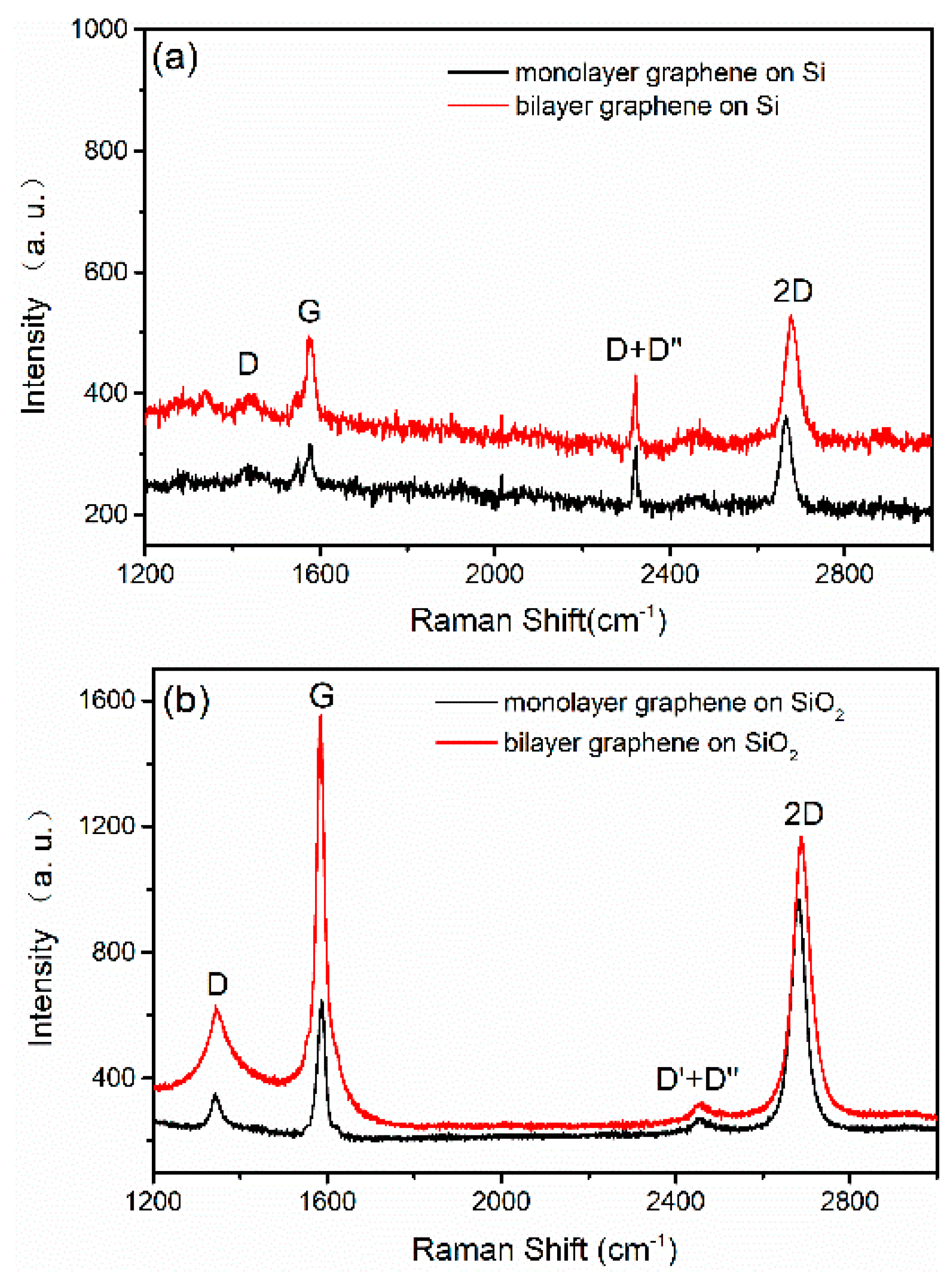
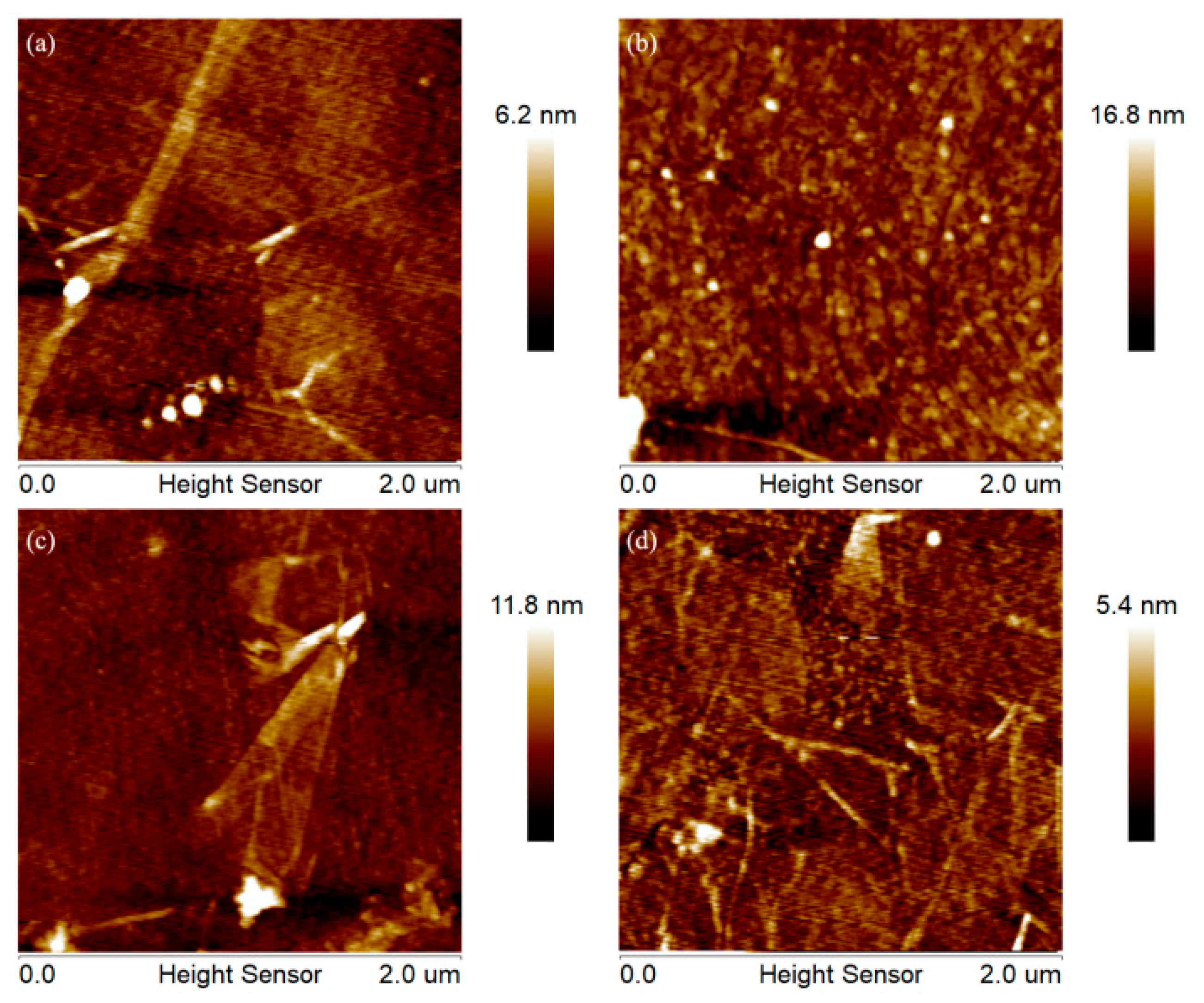


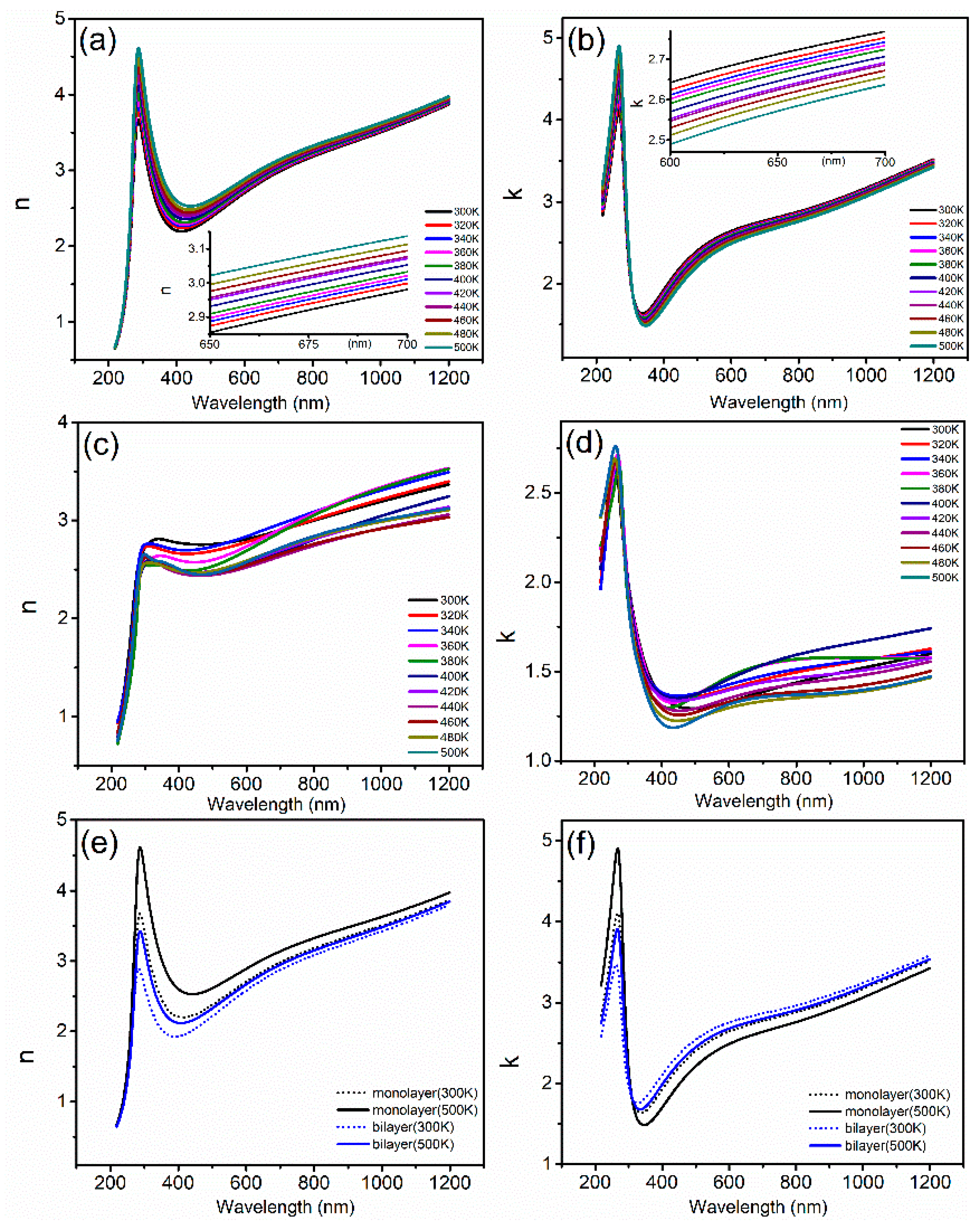
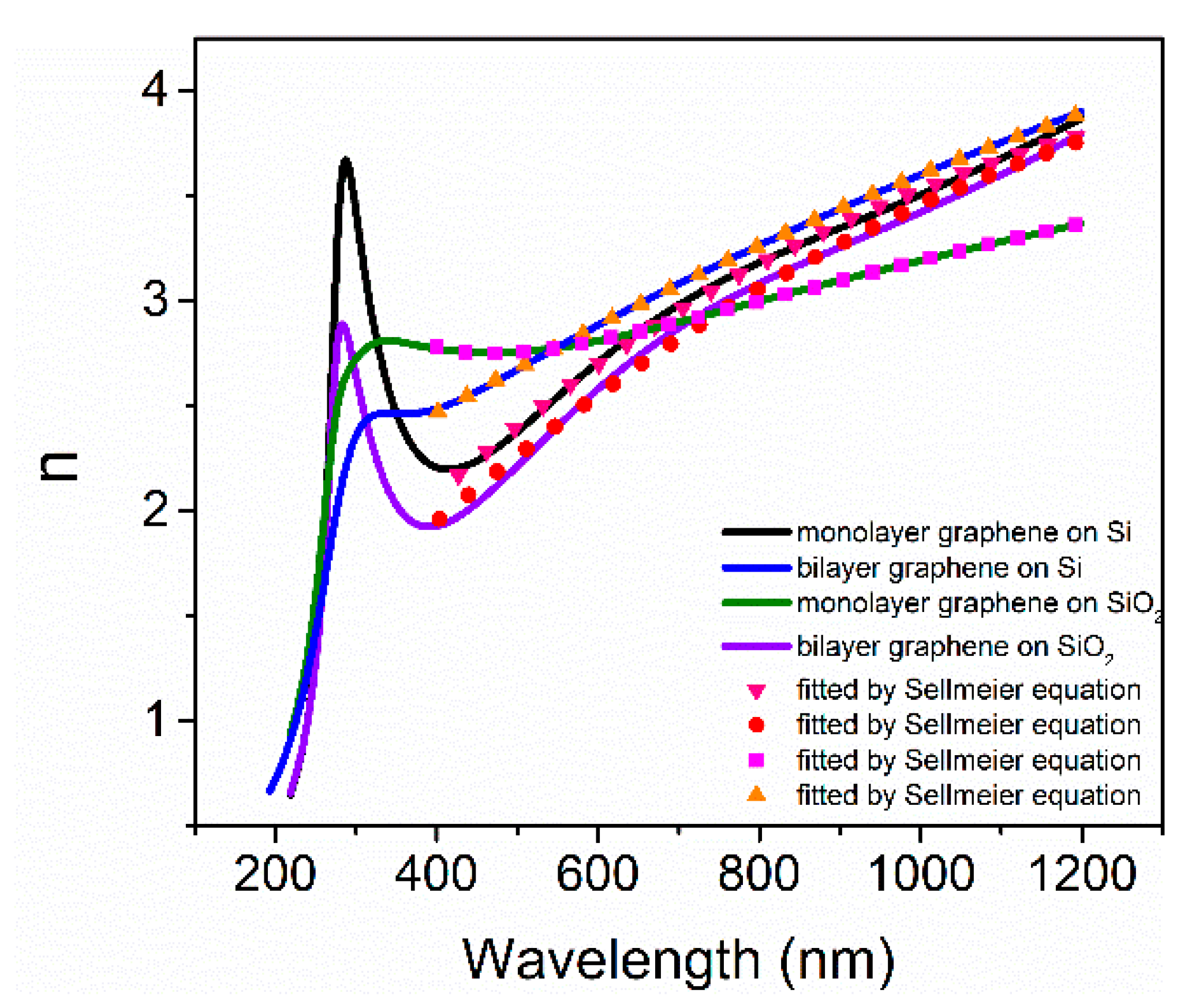
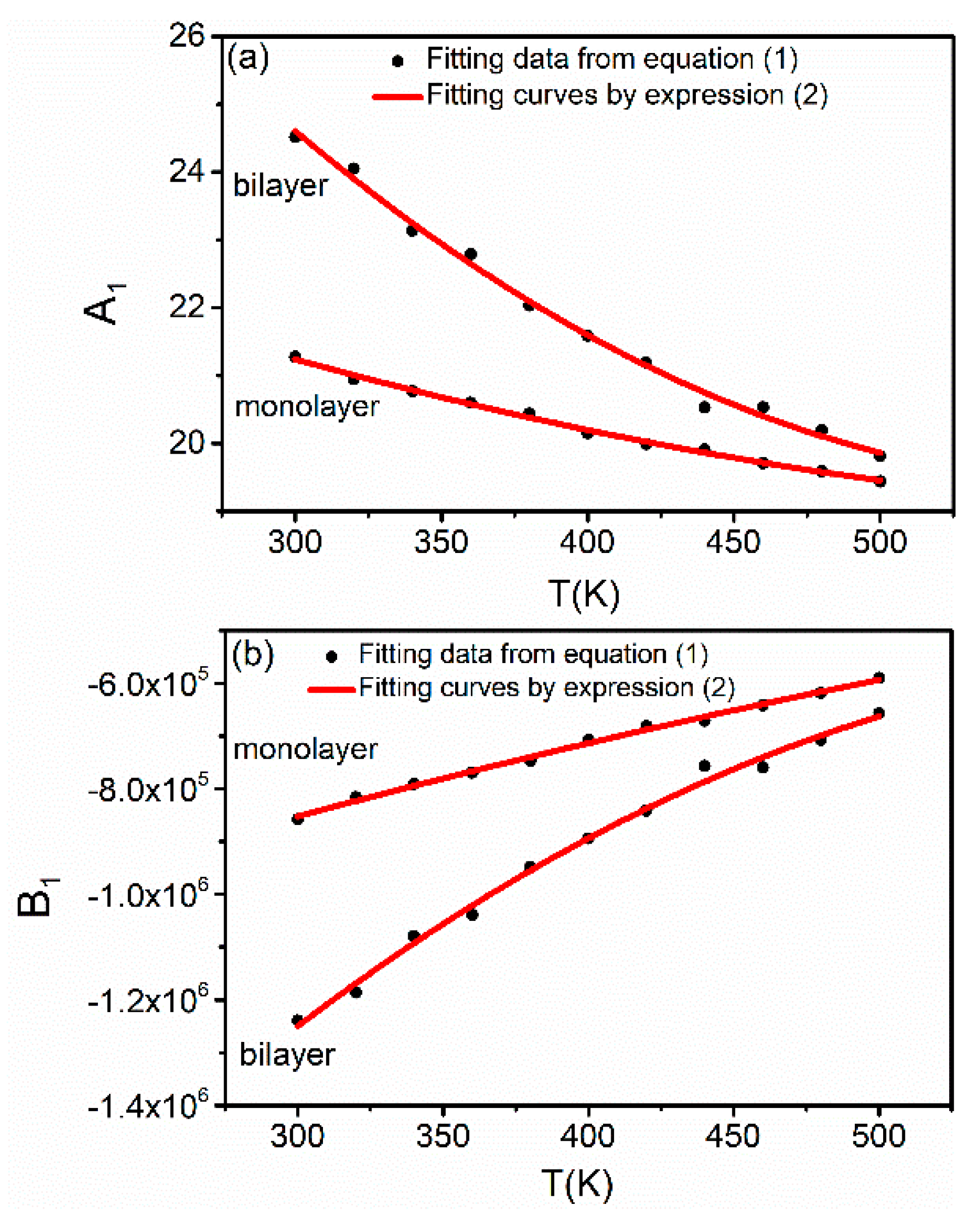
| Samples | 1 Layer on Si | 2 Layers on Si | 1 Layer on SiO2/Si | 2 Layers on SiO2/Si | |
|---|---|---|---|---|---|
| Thickness (nm) | Graphene | 0.380 ± 0.002 | 0.730 ± 0.005 | 0.340 ± 0.001 | 0.880 ± 0.001 |
| Oxide Layer | 4.560 ± 0.004 | 4.700 ± 0.008 | 297.980 ± 0.011 | 293.370 ± 0.011 | |
| MSE | 4.252 | 4.868 | 11.564 | 13.498 | |
| Graphene Samples | Tauc-Lorentz | Amp1 = 108.5431 | Br1 = 1.024 | Eo1 = 0.433 eV | Eg1 = 0.138 eV |
| Monolayer on Si | Tauc-Lorentz | Amp2 = 26.2332 | Br2 = 2.677 | Eo2 = 2.085 eV | Eg2 = 0.233 eV |
| Tauc-Lorentz | Amp3 = 11.5482 | Br3 = 7.543 | Eo3 = 2.944 eV | Eg3 = 0 eV | |
| Tauc-Lorentz | Amp4 = 7.2054 | Br4 = 1.307 | Eo4 = 4.492 eV | Eg4 = 0.191 eV | |
| Tauc-Lorentz | Amp5 = 14.3884 | Br5 = 0.56 | Eo5 = 4.477 eV | Eg5 = 0.87 eV | |
| Drude | Rsisitivity = 0.0008 Ω cm | Scat. Time = 12.576 fs | - | - | |
| Monolayer on SiO2/Si | Tauc-Lorentz | Amp1 = 41.068 | Br1 = 2.783 | Eo1 = 0.329 eV | Eg1 = 0.174 eV |
| Tauc-Lorentz | Amp2 = 24.0227 | Br1 = 2.783 | Eo2 = 1.799 eV | Eg2 = 0.188 eV | |
| Tauc-Lorentz | Amp3 = 14.095 | Br3 = 3.618 | Eo3 = 3.739 eV | Eg3 = 0.476 eV | |
| Tauc-Lorentz | Amp4 = 9.9583 | Br4 = 1.641 | Eo4 = 4.172 eV | Eg4 = 0.554 eV | |
| Tauc-Lorentz | Amp5 = 15.58 | Br5 = 0.904 | Eo5 = 4.594 eV | Eg4 = 2.077 eV | |
| Drude | Rsisitivity = 1000 Ω cm | Scat. Time = 1000 fs | - | - |
| Graphene Samples | A1 | B1 (×105 nm2) | A2 | B2 (×105 nm2) | R2 |
|---|---|---|---|---|---|
| monolayer on Si | 21.40 ± 0.05 | −8.674 ± 0.034 | - | - | 0.99747 |
| bilayer on Si | 24.486 ± 0.124 | −12.360 ± 0.095 | - | - | 0.99418 |
| monolayer on SiO2 | 13.682 ± 0.025 | −17.006 ± 0.078 | 3.935 ± 0.006 | 0.466 ± 0.001 | 0.99987 |
| bilayer on SiO2 | 25.107 ± 0.074 | −20.045 ± 0.162 | 3.713 ± 0.025 | −0.238 ± 0.008 | 0.99992 |
| Graphene Samples | a0 | a1 | a2 (×10−5 K−2) | b0 (×106 nm) | b1 (103 nm2 K−1) | b2 (nm2 K−2) |
|---|---|---|---|---|---|---|
| monolayer on Si | 26.16 ± 0.58 | −0.020 ± 0.002 | 1.495 ± 0.368 | −1.379 ± 0.085 | 2.038 ± 0.430 | −0.932 ± 0.530 |
| bilayer on Si | 41.302 ± 1.790 | −0.074 ± 0.009 | 6.387 ± 1.136 | −3.068 ± 0.228 | 7.94 ± 1.16 | −6.256 ± 1.450 |
Publisher’s Note: MDPI stays neutral with regard to jurisdictional claims in published maps and institutional affiliations. |
© 2021 by the authors. Licensee MDPI, Basel, Switzerland. This article is an open access article distributed under the terms and conditions of the Creative Commons Attribution (CC BY) license (http://creativecommons.org/licenses/by/4.0/).
Share and Cite
Wu, S.; Wan, L.; Wei, L.; Talwar, D.N.; He, K.; Feng, Z. Temperature-Dependent Optical Properties of Graphene on Si and SiO2/Si Substrates. Crystals 2021, 11, 358. https://doi.org/10.3390/cryst11040358
Wu S, Wan L, Wei L, Talwar DN, He K, Feng Z. Temperature-Dependent Optical Properties of Graphene on Si and SiO2/Si Substrates. Crystals. 2021; 11(4):358. https://doi.org/10.3390/cryst11040358
Chicago/Turabian StyleWu, Sisi, Lingyu Wan, Liangmin Wei, Devki N. Talwar, Kaiyan He, and Zhechuan Feng. 2021. "Temperature-Dependent Optical Properties of Graphene on Si and SiO2/Si Substrates" Crystals 11, no. 4: 358. https://doi.org/10.3390/cryst11040358
APA StyleWu, S., Wan, L., Wei, L., Talwar, D. N., He, K., & Feng, Z. (2021). Temperature-Dependent Optical Properties of Graphene on Si and SiO2/Si Substrates. Crystals, 11(4), 358. https://doi.org/10.3390/cryst11040358







